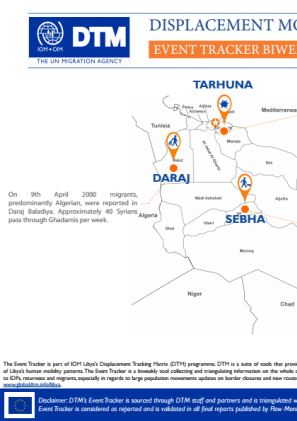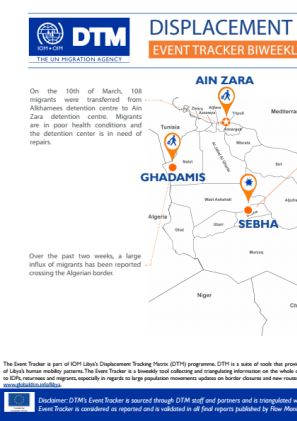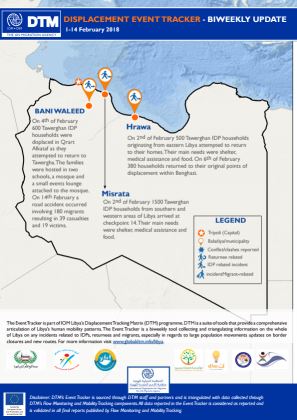-
Countries
-
Data and Analysis
-
Special Focus
-
Crisis Responses
Libya
Sobre Libya
Libya is a geographically vast country with several regions that are difficult to access. In order to understand the full scope of humanitarian assistance that is needed throughout the country, IOM established the Displacement Tracking Matrix (DTM) programme in 2016 in order to provide a common operating picture concerning the movement of populations in Libya, allowing humanitarian actors to provide timely assistance to those in need. Following the escalation of conflict and insecurity in 2014, the security situation has remained volatile since with fluctuations in the intensity of localized clashes. Congruently, conflict has caused new displacements, often in areas ill-equipped to accommodate large population movements while also negatively impacting the large migrant population residing and transiting through Libya. More recently, the capital Tripoli was heavily affected by displacement waves in September 2018 and April 2019.
DTM’s mobility tracking and flow monitoring activities identified many migrants in-country to be in need of various forms of assistance. Libya’s geographic location, resources and work opportunities has made it both a country of destination and transit for migrants for many years. Despite the deterioration of the security situation since 2011 migrants continue coming to and transiting through Libya, the majority from Sub-Saharan and North African countries.
In this complex operating environment, DTM Libya has been providing a common operating picture concerning the movement of populations in Libya since 2016, allowing humanitarian actors to provide timely assistance to those in need. Through its mobility tracking, flow monitoring and needs assessment activities, DTM Libya has established itself as data hub for quantitative data on migratory flows to and within Libya, migrant presence in Libya disaggregated by nationality and area, as well as humanitarian needs of migrants, internally displaced population and returnees. All activities are implemented through periodical bi-monthly data collection cycles, allowing trend analysis over time to provide evidence-base for both policy-level discussions and to guide humanitarian action.
In order to facilitate humanitarian interventions, DTM works closely with IOM’s other programmes through referring identified populations in need of assistance at flow monitoring points to IOM’s Direct Assistance, Health, Voluntary Humanitarian Return (VHR), Protection and Migrant Rapid Response Mechanism (MRRM) programmes. Furthermore, DTM Libya supports other humanitarian partners through providing emergency tracking updates in case of sudden population movements as well as facilitating humanitarian assessments for the Rapid Response Mechanism (RRM) jointly implemented by IOM, UNICEF, WFP and UNFPA.
For more information on IOM's activities in Libya, please visit the IOM Libya country office website.
Contacto
DTM Libya
DTMLibya@iom.int
Current Donors
- EUTF
Para obtener resultados de búsqueda más avanzados, vaya a la Página de búsqueda avanzada de informes
Libya — IDP and Returnee Key Findings Report 19 (March — April 2018)
This publication presents DTM’s Round 19 key findings on Libya’s IDP & Returnee populations. DTM’s Round 19 covers the period of mid March and April 2018.
Libya — IDP and Returnee Report 19 (March — April 2018)
The publication presents DTM's Round 19 complete information packages on Libya's IDP and Returnee Populations. DTM's Round 19 covers the period of mid March to mid April 2018, delivering a comprehensive Mobility Tracking report on Libya's IDP & Returnee population.
Libya — Sebha Alert Snapshot (13 May 2018)
As a result of armed clashes in Sebha, 80 households (approximately 400 individuals) have been displaced to private and public buildings in the center of the city, with a further 60 households (300 individuals) displaced to the Baladiya of Murzuq.
May 13 2018
Libya — Sebha Alert Snapshot (13 May 2018)
(2018 ليبيا — تقرير تتبّع أحداث النّزوح (20 أبريل — 10 مايو
الجميل: في الفاتح من مايو، بلغنا وقوع اشتباكات بين جماعات محلّية مسلّحة وأهالي الزنتان على أطراف مدينة الجميل. ولم يحدث نزوح نتيجة لذلك ولا زالت الجهود المسخّرة للمصالحة قائمة على قدم وساق.
Libya — Displacement Event Tracking Report (20 April — 10 May 2018)
Published on a bi-weekly basis, the Displacement Event Tracker reports on incidents related to IDPs, returnees and migrants, especially in regards to large population movement updates.
Libya — Maritime Update Libyan Coast (April 2018)
IOM’s Maritime Update provides snapshots relating to the number of maritime incidents off the Libyan coast, as well as latest figures on Italy arrivals and recorded deaths along the Central Mediterranean Route.
Libya — Migrant Report 18 (March 2018)
In Round 18, DTM Libya’s Mobility Tracking identified 662,248 migrants in 99 baladiyas and 551 muhallas. 91% of identified migrants were men, while 9% were women.
Apr 30 2018
Libya — Migrant Report 18 (March 2018)
Migrant Report Key Findings 18 (March 2018)
In Round 18, DTM Libya’s Mobility Tracking identified 662,248 migrants in 99 baladiyas and 551 muhallas. 91% of identified migrants were men, while 9% were women.
Apr 30 2018
Migrant Report Key Findings 18 (March 2018)
Libya — Displacement Event Tracking Report (9 April - 20 April)
Published on a bi-weekly basis, the Displacement Event Tracker reports on incidents related to IDPs, returnees and migrants, especially in regards to large population movement updates.
Libya — Maritime Update Libyan Coast (1 — 31 March 2018)
IOM’s Maritime Update provides snapshots relating to the number of maritime incidents off the Libyan coast, as well as latest figures on Italy arrivals and recorded deaths along the Central Mediterranean Route. Between 1 and 31 March 2018, 1,058 individuals were rescued
Libya — Return Intention Survey 1 (14—21 March 2018)
In March 2018, the Displacement Tracking Matrix Libya (DTM) conducted a demographic and socio-economic survey of the Tawergha internally displaced person (IDP) population living in IDP settlements across Libya.
Libya - IDP and Returnee Report 18 (February — March 2018)
The publication presents DTM's Round 18 complete information packages on Libya's IDP and Returnee Populations. DTM's Round 18 covers the period of mid February to March 2018, delivering a comprehensive Mobility Tracking report on Libya's IDP & Returnee population.
Libya - IDP and Returnee Key Findings Report R18 (Feb-March 2018)
This publication presents DTM’s Round 18 key findings on Libya’s IDP & Returnee populations. DTM’s Round 18 covers the period of late February and March 2018.
Libya — Displacement Event Tracking Report (28 February — 13 March 2018)
Published on a bi-weekly basis, the Displacement Event Tracker reports on incidents related to IDPs, returnees and migrants, especially in regards to large population movement updates.
Libya — Maritime Update Libyan Coast (1—28 February 2018)
IOM’s Maritime Update provides snapshots relating to the number of maritime incidents off the Libyan coast, as well as latest figures on Italy arrivals and recorded deaths along the Central Mediterranean Route. Between 1 and 28 February 2018, 375 individuals were rescued or intercepted and 3
Libya — Sebha Alert Snapshot (8 March 2018)
As a result of continued armed clashes in the city of Sebha, 720 households (approximately 3,600 individuals) have been displaced to the Muhallas of Al minshiyah (530 HH), Sakra-Mahdia (140 HH) and Ubari (50 HH).
Mar 08 2018
Libya — Sebha Alert Snapshot (8 March 2018)
Libya — Tawergha Return Weekly Update 3 (3 March 2018)
IDPs continue to wait in order to return to their community of origin as their number increases. Currently, more than 2,200 individuals are reported to be in Qararat Al-Katf and Harawa informal settlements.
Libya — Baladiya Data Generator Round 17
This is an interactive profile generator that displays snapshots of each of Libya’s 100 baladiyas gathered through DTM Libya’s Mobility Tracking assessments. Basic multisectorial data on the baladiya is presented in addition to data on IDPs, returnees and and migrants in the baladiya.
Feb 28 2018
Libya — Baladiya Data Generator Round 17
Libya — Tawergha Return Weekly Update 2 (24 February 2018)
Tawerghan IDPs are facing multiple challenges that continue to prevent them from returning to their homes. School holidays have been underway since the 23rd February, resulting in a consistent increase in the number of IDPs in the camps.
Libya — Displacement Event Tracking Report (14—27 February 2018)
Published on a bi-weekly basis, the Displacement Event Tracker reports on incidents related to IDPs, returnees and migrants, especially in regards to large population movement updates.
Libya - IDP and Returnee Report 17 (January — February 2018)
This publication presents DTM’s Round 17 complete information packages on Libya’s Migrant and IDP & Returnee populations.
Libya — IDP and Returnee Key Findings R17 (Jan-Feb 2018)
This publication presents DTM’s Round 17 key findings on Libya’s Migrant and IDP & Returnee populations. DTM’s Round 17 covers the period of late January and February 2017.
Libya — Displacement Event Tracking Report (1—14 February 2018)
In Bani Waleed, on 4th of February 600 Tawerghan IDP households were displaced in Qrart Alkataf as they attempted to return to Tawergha. In addition, On 14th February a road accident occurred involving 180 migrants resulting in 39 casualties and 19 victims.
Libya — Migrant Report 17 (January — February 2018)
In Round 17 DTM Libya’s Mobility Tracking identified 704,142 migrants in 99 baladiyas and 5551 muhallas. 88% of identified migrants were men, while 12% were women.
Pagination
Para obtener resultados de búsqueda más avanzados, vaya a la Página de búsqueda avanzada de conjuntos de datos
Pagination
- First page
- Previous page
- 1
- 2
- 3
- 4
- 5


























